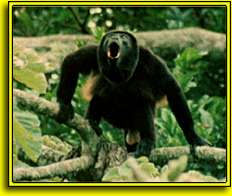| H o w l e r m o n k e y
Howlers are large monkeys with prehensile tails and bearded faces. Fur colors ranges from bright reddish to brown to black. The names come from their most distinctive feature—a ferocious, loud, and according people who have been awakened from sleep by howlers, almost unearthly voice that echoes throughout the rainforest at sunrise and sunset. Male howlers have specialized throat structures that, like a megaphone, amplify their calls so they resonate for nearly a mile through the rainforest. Howlers mark their territory: through their calls, they are communicating the location of their “turf” to other troops, thus avoiding a face-to-face or troop-to-troop confrontation. Howlers have a social structure: males are dominant over females; troops generally consist of 3 adult males, 7-8 adult females and a varying number of juveniles. Their prehensile tails and strong claws are designed for gripping and leaping from branch to branch, so these leaf-eating, tree-dwelling “swingers” rarely have to come down to earth. (See GHS’ journal for more on howler monkeys, ad Program 2 for how howler monkeys play a role in Ellen Andresen’s studies of Dung Beetles.) |
![]()
 Howlers can be found all over the U. C. neotropics. There are six species, two of which are considered endangered.
Howlers can be found all over the U. C. neotropics. There are six species, two of which are considered endangered.